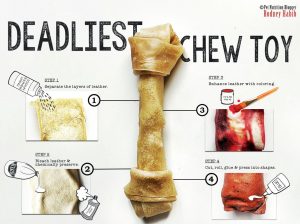Puppies are notoriously aggressive chewers, but some dogs never grow out of chewing. If you want to save your shoes or furniture from untimely destruction, you probably offer your furry friend rawhide treats to alleviate their tendency to chew.
But could you be unknowingly putting your dog in danger? Los Angeles-based holistic veterinarian Dr. Patrick Mahaney is outlining some of the hidden dangers of feeding rawhides and offering some alternatives to appease your little chewer while keeping him safe.
Rawhide Manufacturing
Rawhides are made from the inner layer of cow or horse hides (source). By the time they make it to the store, they are clean, usually white or brown, hard chews.
But what goes into making these chews? Pet nutrition blogger Rodney Habib describes the chemical-laden manufacturing process used for preserving and cleaning the hides. Things like hydrogen peroxide and bleach are commonly used, as well as artificial colors and preservatives like sodium benzonate, according to Habib.
To avoid chemical byproducts, it’s important to do some research. Read labels or even call the manufacturer to ask what preservatives they used.
“Your typical manufacturer is going to use a chemical preservative to make sure the rawhide doesn’t spoil,” Dr. Mahaney says.
“They don’t necessarily have to say what chemicals were used on the label. Unless we know it doesn’t [contain chemical preservatives], we should assume it does and avoid it.”
“Your typical manufacturer is going to use a chemical preservative to make sure the rawhide doesn’t spoil.”
Dr. Mahaney suggests looking for labels that say “preservative free,” or otherwise indicate no chemical preservatives were used to manufacture the rawhides. He says family farms who slaughter their own cows and dry their hides naturally in the sun are ideal.
“Rawhides aren’t inherently evil,” Dr. Mahaney adds. “If dogs chew on a rawhide without chemicals, I’m not 100% anti-rawhides.”
In fact, rawhides can keep an aggressive chewer captive for hours—but make sure you monitor their intake and limit their chewing to an hour a day or less if they can tear through an entire rawhide in that time.
Dangers of Rawhides
Apart from the chemicals used to preserve most rawhides, there are some other risks with feeding these hard chews to your pet: mainly choking and getting lodged in the throat. Getting a bit of rawhide stuck in the esophagus is a dangerous and potentially deadly situation.
“Getting access to it is extremely challenging,” Dr. Mahaney says. “The best way is with an endoscope but if one of the edges scrapes the inside of the esophagus, whatever is in the esophagus will leak out in small or large volumes, which can cause irritation and infection, too.”
If your dog does start to choke, try to pull the piece of rawhide out.
“It’s better to pull it forward than push it down,” Dr. Mahaney adds.
But even if you can remove the rawhide yourself, you should still take your dog to the vet.
“You should go to your vet right away because in the process of pulling the rawhide out, you may have created some damage in the back of the throat,” Dr. Mahaney explains.
Rawhides can also pose risks to the teeth.
“Hard rawhides with an aggressively chewing dog can damage teeth,” Dr. Mahaney adds. “Usually they soften up with saliva but not always.”
Teeth-Cleaning Myths
Most pet parents think rawhides are great for cleaning their dog’s teeth. While there is some validity to that, there are better options for keeping your dog’s chompers clean and their gums healthy.
“Hard rawhides with an aggressively chewing dog can damage teeth.”
“Chewing on a treat does not equal a toothbrush,” Dr. Mahaney says. “Ideally, you should be brushing daily and working with your vet for treatment like anesthesia teeth cleaning.”
Studies show there is a correlation between canine tooth decay and the type of food they eat, especially kibbles and certain carb-heavy treats.
“These leave more easily fermentable carbohydrates on the teeth that bacteria can grow on,” Dr. Mahaney explains.
Alternative Options
There are a number of safe, healthy alternatives to rawhides:
- The Honest Kitchen Beams Chews: “These are pure Icelandic catfish skins with no preservatives,” Dr. Mahaney explais. “They are rich in omega fatty acids and even have a mild abrasive effect that can reduce tartar, almost like a toothbrush.”
- Vibrac C.E.T. Enzyme Rawhide Chews: “These have enzymes that break down tartar but they are made with beef rawhide,” Dr. Mahaney says. “I wouldn’t suggest your dog chews one everyday, but if you have an aggressive chewer who isn’t going to swallow it hole, it’s an option.”
- PetSafe Indigo Fresh Floss Bones
- Bully Sticks: “They tend to be softer and once they are moistened, they’re fine,” Dr. Mahaney says. “But they could be coated with chemical preservatives and if they are hard, they can still damage teeth and get stuck in the esophagus.”
The Bottom Line
Redirecting your dog’s natural tendency to chew by offering a tasty treat can save your furniture or shoes from destruction, but you need to make sure you know how your chews are being processed. Always monitor your dog with any chew toy and take and throw away the small pieces as he gets to the end of the chew to prevent choking.

No se han encontrado comentarios